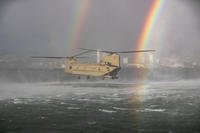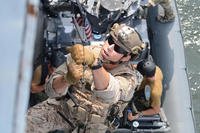It was around 5:20 a.m., still well before sunrise, as the guided-missile destroyer John S. McCain prepared to enter the Singapore Strait, at the south end of the Straits of Malacca, on Aug. 21.
Though the ship was due to enter the famously busy shipping lane around 6 a.m., the commanding officer, Cmdr. Alfredo Sanchez, had yet to summon the sea and anchor detail, the team that provides additional assistance when entering port or navigating narrow spaces.
Sanchez had been on the bridge since 1:15 a.m. His executive officer, Cmdr. Jesse Sanchez, had joined him at 4:30.
As the commanding officer observed activities on the bridge, he noted that the ship's helmsman was having trouble staying on course while adjusting throttles for speed control.
Related content:
- Navy: Failures of Leaders, Watchstanders Led to Deadly Ship Collisions
- Watchstanders Looking Wrong Way Before Fitzgerald Collision: Navy
- Navy Sacks USS McCain Leaders After 'Preventable' Deadly Collision
Sanchez jumped in to remedy the problem, ordering the watch team to divide up steering and throttle duties. While the helmsman would continue to maintain course control, another station -- directly to the right of the helmsman's post -- would take on speed control.
Somehow, though, the message wasn't communicated properly. Steering control was shifted to the Lee Helm station on the right, and the helmsman went into crisis mode, announcing that the ship had lost all steering.
Reports in the wake of the collision that the McCain had lost steering spurred rumors and theories that the ship had been the victim of a malicious cyberattack that led to the collision. In fact, there was no such problem -- just massive confusion over who was in control.
According to an investigation report on the disaster that resulted from this seemingly minor steering snafu, the minutes that followed this reported loss of steering would set the ship on a deadly collision course. By daybreak, 10 sailors would be dead.
Transferring steering control to the Lee Helm station as a result of confusion over Sanchez' command caused the rudder to go centerline, according to the report.
Since the ship had been steering to the right, or starboard, this caused a deviation in course.
The helmsman's announcement that steering had been lost prompted Sanchez to call for the ship's speed to be cut in half, from 10 knots to 5 knots.
But this emergency measure exacerbated the problem, as the left and right throttles were not working together. The result was a wide, uncontrolled turn to the left.
The McCain was now on course to collide with the Liberian-flagged oil tanker Alnic MC. But somehow, the officials on the bridge could not see the impending disaster.
Investigators note that bridge-to-bridge communications between the two ships might have prevented the collision. But no such communication occurred. Instead, they continued to work to regain control of steering, ultimately getting full command of the ship three minutes after the initial crisis.
Moments later, Alnic MC rammed into the side of the McCain, creating a 28-foot diameter hole in the ship and flooding the McCain's Berthing 5 quarters almost instantly.
The Collision
According to the investigation, the jolt as the two ships collided was so powerful that watchstanders were thrown off their feet and some sailors were injured in the impact.
"Sailors in parts of the ship away from the impact point compared it to an earthquake," investigators wrote. "Those nearest the impact point described it as like an explosion."
Damage control efforts began immediately and, within minutes, the McCain had requested tugboats from Singapore Harbor to assist in pulling the ship to nearby Changi Naval Base.
As the ship flooded, it began to list to its port, or left, side. The ship lit its "red-over-red" signal, indicating it was not under command and was unable to maneuver.
Ultimately, three sections near the point of impact were affected by the collision: Berthings 5, 3, and 7. Berthing 5, below the water line, would be the hardest hit. Of the 12 sailors in this section when the ships collided, only two would make it out; the remaining 10 would be lost.
The two who escaped barely made it out as the compartment flooded within seconds. One was on the ladder at the time of the collision and quickly scrambled up; the other maneuvered toward the ladder underwater by feel, aided only by emergency lighting. He emerged scraped, bruised, and covered by chemical burns from exposure to fuel.
"The sailor found that the blindfolded egress training, a standard that requires training to prepare sailors for an emergency and was conducted when he reported to the command, was essential to his ability to escape," investigators found.
In Berthing 3, the compartment directly above, sailors were bruised and bloodied from the force of impact and jagged exposed metal from the collision.
One sailor, pinned in his rack, had to be rescued with a "jaws of life" device. Ultimately, all these sailors were evacuated as berthing spaces continued to flood. Five sailors required medical evacuation.
In all, 48 sailors had injuries that required medical treatment, ranging from broken bones to lacerations and burns, according to the investigation, and 43 stayed aboard to continue to help the ship recover.
Investigators credit the resiliency and responsiveness of the McCain's crew for the ship's ability to move under its own power to Changi, despite the challenges of steering the ship as it leaned to port, and the degraded navigation and communication equipment.
It would take a dive team several days, searching by feel in the dark below-decks berthing, to recover the bodies of all 10 fallen sailors.
Lost in the collision were:
- Chief Electronics Technician Charles Nathan Findley, 31, of Amazonia, Missouri
- Chief Interior Communications Electrician Abraham Lopez, 39, of El Paso, Texas
- Electronics Technician 1st Class Kevin Sayer Bushell, 26, of Gaithersburg, Maryland
- Electronics Technician 2nd Class Jacob Daniel Drake, 21, of Cable, Ohio
- Information Systems Technician 2nd Class Timothy Thomas Eckels Jr., 23, of Baltimore
- Informations Systems Technician 1st Class Corey George Ingram, 28, of Poughkeepsie, New York
- Electronics Technician 2nd Class Dustin Louis Doyon, 26, of Suffield, Connecticut
- Electronics Technician 2nd Class John Henry Hoagland III, 20, of Killeen, Texas
- Interior Communications Electrician 2nd Class Logan Stephen Palmer, 23 of Harristown, Illinois
- Electronics Technician 2nd Class Kenneth Aaron Smith, 22, of Cherry Hill, New Jersey
All were posthumously promoted to those ranks.
Findings
Investigators found confusion and lack of sufficient knowledge led to the steering errors that ultimately caused the collision.
Several sailors on watch, they found, had been temporarily assigned from the cruiser Antietam, which has a significantly different steering control system, and they lacked the training to compensate for the differences. Four different stations could have taken control of steering when it was declared lost, but no one did.
"Multiple bridge watchstanders lacked a basic level of knowledge on the steering control system, in particular the transfer of steering and thrust control between stations," investigators found.
"Contributing, personnel assigned to ensure these watchstanders were trained had an insufficient level of knowledge to effectively maintain appropriate rigor in the qualification program," they said. "The senior most officer responsible for these training standards lacked a general understanding of the procedure for transferring steering control between consoles."
Investigators also faulted Sanchez, the commanding officer, for not setting a sea and anchor detail sooner in the heavily trafficked waters. If the detail had been set, the collision likely would not have occurred, they found.
Finally, senior officers and watchstanders did not question the helmsman's report that steering had been lost -- a report that would turn out to be erroneous.
Ultimately, the commanding and executive officers of the McCain would be relieved from their posts Oct. 11 for failure to avert the "preventable" collision.
Chief of Naval Operations Adm. John Richardson is set to publicly address the collisions Thursday at the Pentagon with the release of a wide-ranging review of Navy procedures commissioned following the McCain's collision.
-- Hope Hodge Seck can be reached at hope.seck@military.com. Follow her on Twitter at @HopeSeck.














